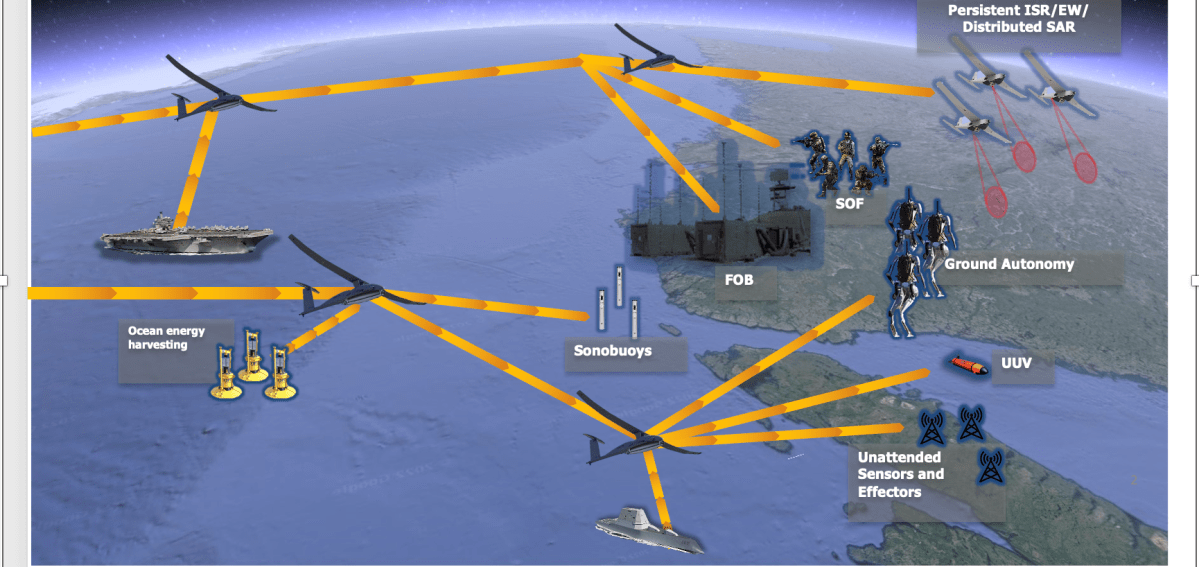DARPA picks vendors to help develop ‘wireless energy web’ for drones, other military forces

The first phase of the Persistent Optical Wireless Energy Relay (POWER) program is kicking off, the Defense Advanced Research Projects Agency announced on Thursday.
RTX Corp., Draper Laboratory and BEAM Co. will each lead teams tasked with developing technologies to enable a “wireless energy web” that could help power U.S. military forces around the globe.
DARPA envisions a “distributed, resilient, multi-input, multi-output power, multi-path energy beaming network” that can generate and transmit power and “enable persistent operation of a new generation of distributed unmanned systems, sensors, and effectors,” according to slides from a proposers day that was held last fall.
The slides depicted sea-based energy harvesting platforms beaming energy up to unmanned aerial vehicles, which then beam it to other drones and aircraft, ships and unmanned underwater vessels, ground robots, special operations forces, forward operating bases, sonobuoys, and other “unattended sensors and effectors.”
The industry teams tapped for phase one of the POWER program will design and develop wireless optical power relays.
“Effective relays are a critical missing component necessary for a practical, flexible, and adaptive wireless energy web. These relays will overcome the unacceptable conversion losses that occur when changing from propagating waves to electricity repeatedly in a multiple-hop network. Relays also enable high-altitude transmission, which is vastly more efficient than beaming power through the thick, turbulent, lower atmosphere. This high-altitude optical layer will provide the long-range, high throughput backbone for the wireless energy web,” DARPA said in a release.
Phase one will involve conceptual designs and “benchtop demonstrations,” according to the agency.
Phase two — which will be preceded by an open solicitation slated for early 2025 — will include integration of the relay technologies onto an existing platform for a low-power, airborne demonstration with pods carried by existing aircraft.
The third and final phase will include a demonstration that uses three airborne relay nodes to transmit 10 kilowatts of optical energy from a ground-based laser up to high-altitude platforms, and back down to a ground receiver 200 kilometers away, according to DARPA.
The Defense Department is expected to provide high-altitude, long-endurance RQ-4 Global Hawk drones for the airborne relay demos.
“It is envisioned that the platforms will be operating at or around 60,000 feet to minimize atmospheric losses and enhance relay survivability. Efficient and precise redirection is necessary to avoid platform thermal challenges and to ensure the relayed beam effectively illuminates the desired target. To account for degradation of beam quality as the beam transits atmospheric disturbances, the relay must be able to correct the optical wavefront as needed to achieve system efficiency goals. Finally, the relays must be able to selectively harvest energy from the optical beam to provide on-board auxiliary power and thereby demonstrate necessary characteristics for future indefinitely persistent relay platforms,” according to a broad agency announcement that was issued before the contracts for phase one were awarded.
The kickoff of the POWER program comes as the Defense Department is looking to begin fielding larger numbers of unmanned and autonomous systems, including long-endurance platforms.
The Pentagon is also worried about operational energy challenges and contested logistics in future operating environments — such as a potential conflict with China in the Indo-Pacific — where adversaries could make it difficult for the U.S. military to resupply its forces via traditional means.
“Energy underpins every human activity, including defense. We need ways to deliver energy that overcome the vulnerabilities and other shortcomings of our current paradigm,” POWER program leader Paul Jaffe said in a statement.
“This project has the potential to advance power beaming by orders of magnitude … A wireless energy web could unlock power from new and diverse sources, including from space, and rapidly and reliably connect them to energy-starved consumers,” he added.



